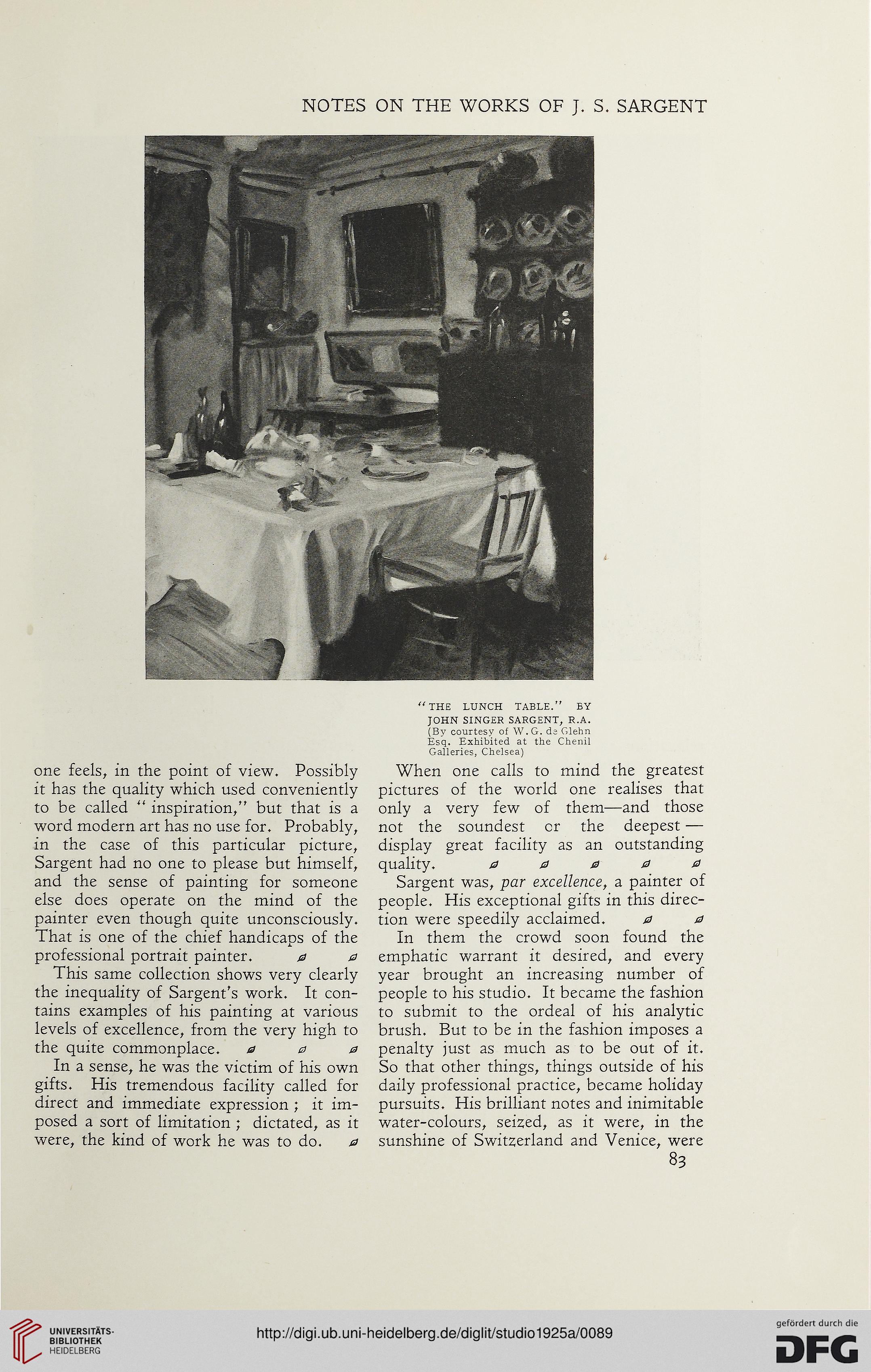NOTES ON THE WORKS OF J. S. SARGENT
THE LUNCH TABLE. BY
JOHN SINGER SARGENT, R.A.
(By courtesy of W.G. Glehn
Esq. Exhibited at the Chenil
Galleries, Chelsea)
one feels, in the point of view. Possibly When one calls to mind the greatest
it has the quality which used conveniently pictures of the world one realises that
to be called " inspiration," but that is a only a very few of them—and those
word modern art has no use for. Probably, not the soundest or the deepest —
in the case of this particular picture, display great facility as an outstanding
Sargent had no one to please but himself, quality. 00000
and the sense of painting for someone Sargent was, par excellence, a painter of
else does operate on the mind of the people. His exceptional gifts in this direc-
painter even though quite unconsciously, tion were speedily acclaimed. a 0
That is one of the chief handicaos of the In them the crowd soon found the
professional portrait painter. 0 0 emphatic warrant it desired, and every
This same collection shows very clearly year brought an increasing number of
the inequality of Sargent's work. It con- people to his studio. It became the fashion
tains examples of his painting at various to submit to the ordeal of his analytic
levels of excellence, from the very high to brush. But to be in the fashion imposes a
the quite commonplace. 000 penalty just as much as to be out of it.
In a sense, he was the victim of his own So that other things, things outside of his
gifts. His tremendous facility called for daily professional practice, became holiday
direct and immediate expression ; it im- pursuits. His brilliant notes and inimitable
posed a sort of limitation ; dictated, as it water-colours, seized, as it were, in the
were, the kind of work he was to do. a sunshine of Switzerland and Venice, were
83
THE LUNCH TABLE. BY
JOHN SINGER SARGENT, R.A.
(By courtesy of W.G. Glehn
Esq. Exhibited at the Chenil
Galleries, Chelsea)
one feels, in the point of view. Possibly When one calls to mind the greatest
it has the quality which used conveniently pictures of the world one realises that
to be called " inspiration," but that is a only a very few of them—and those
word modern art has no use for. Probably, not the soundest or the deepest —
in the case of this particular picture, display great facility as an outstanding
Sargent had no one to please but himself, quality. 00000
and the sense of painting for someone Sargent was, par excellence, a painter of
else does operate on the mind of the people. His exceptional gifts in this direc-
painter even though quite unconsciously, tion were speedily acclaimed. a 0
That is one of the chief handicaos of the In them the crowd soon found the
professional portrait painter. 0 0 emphatic warrant it desired, and every
This same collection shows very clearly year brought an increasing number of
the inequality of Sargent's work. It con- people to his studio. It became the fashion
tains examples of his painting at various to submit to the ordeal of his analytic
levels of excellence, from the very high to brush. But to be in the fashion imposes a
the quite commonplace. 000 penalty just as much as to be out of it.
In a sense, he was the victim of his own So that other things, things outside of his
gifts. His tremendous facility called for daily professional practice, became holiday
direct and immediate expression ; it im- pursuits. His brilliant notes and inimitable
posed a sort of limitation ; dictated, as it water-colours, seized, as it were, in the
were, the kind of work he was to do. a sunshine of Switzerland and Venice, were
83




